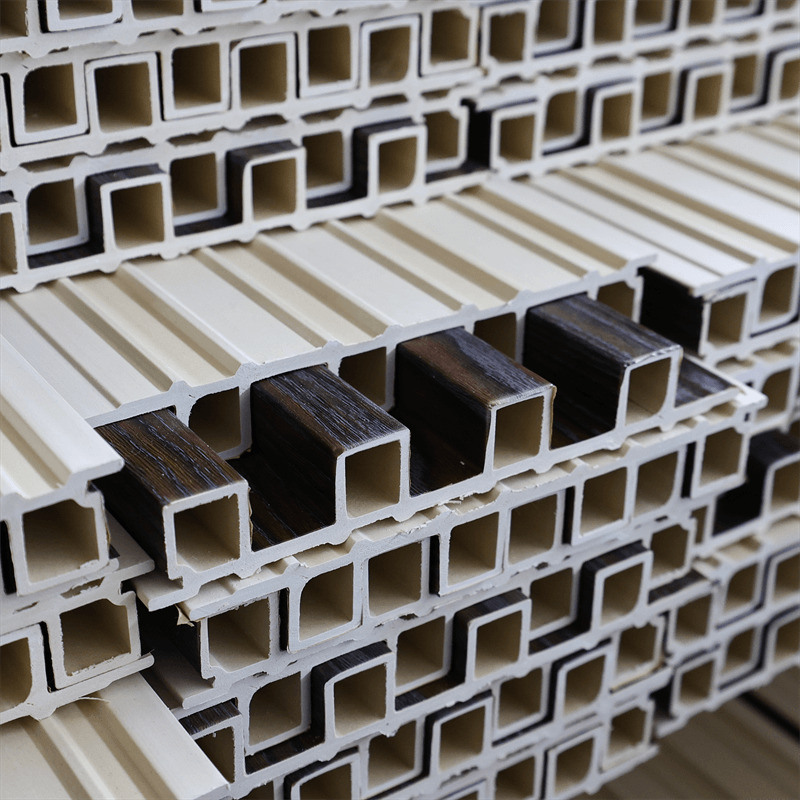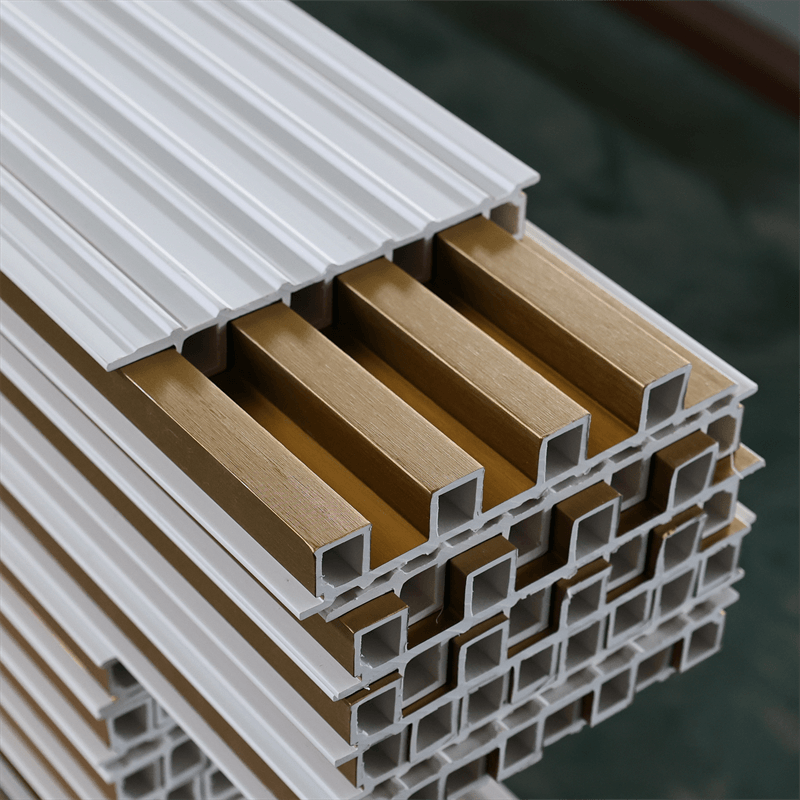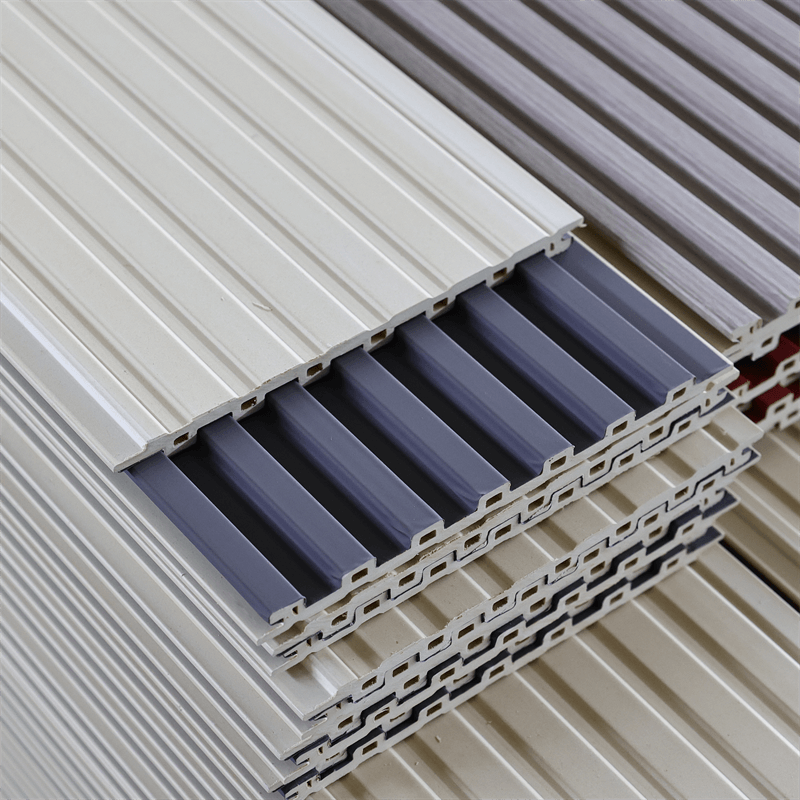In an era of increasing environmental awareness, creating a green home has become a top priority for many homeowners.
Choosing sustainable building materials is a crucial step in this process, and wood-plastic composite (WPC) wall panels offer a compelling solution.
This essay explores the benefits of WPC wall panels in creating a green home, focusing on their eco-friendly composition, energy efficiency, indoor air quality improvement, and contribution to sustainable living.

I. Eco-Friendly Composition: A Sustainable Choice
WPC wall panels are crafted from a blend of recycled wood fibers and recycled plastic, making them an eco-friendly alternative to traditional wall cladding materials.
By utilizing recycled materials, WPC panels help reduce the demand for virgin resources and divert waste from landfills.
This sustainable composition addresses the growing concern of deforestation and waste accumulation, contributing to a greener future.
Moreover, the production process of WPC panels consumes less energy and releases fewer greenhouse gas emissions compared to other construction materials.
This reduces the carbon footprint associated with the manufacturing of building materials, making WPC wall panels a responsible choice for eco-conscious homeowners.
II. Energy Efficiency: Reducing Environmental Impact
Creating a green home goes beyond the materials used; it also involves optimizing energy efficiency.
WPC wall panels contribute to energy conservation by providing effective insulation properties.
The composition of WPC panels helps to regulate indoor temperatures, reducing the need for excessive heating or cooling and minimizing energy consumption.
The insulation properties of WPC wall panels also contribute to noise reduction, creating a more serene and comfortable living environment.
By minimizing the transfer of sound, homeowners can enjoy a peaceful atmosphere while reducing the reliance on energy-consuming soundproofing solutions.
III. Indoor Air Quality Improvement: Healthier Living Spaces
Another significant aspect of creating a green home is ensuring good indoor air quality.
Traditional building materials, such as paints or adhesives, can emit volatile organic compounds (VOCs) that negatively affect indoor air quality and pose health risks.
WPC wall panels offer a healthier alternative, as they do not contain harmful VOCs.
The absence of VOC emissions from WPC panels improves the overall indoor air quality, creating a healthier living space for occupants.
This is particularly important for individuals with respiratory conditions or allergies, as WPC panels help reduce the presence of airborne pollutants and irritants.
Furthermore, WPC wall panels are resistant to mold and mildew growth, preventing the accumulation of harmful microorganisms in the home.
This contributes to a cleaner and safer indoor environment, ensuring the well-being of the occupants.
IV. Contribution to Sustainable Living: Reducing Waste and Maintenance
Sustainable living involves minimizing waste generation and adopting low-maintenance solutions.
WPC wall panels excel in both aspects, making them an ideal choice for those seeking a green home.
Firstly, WPC panels are designed to be long-lasting and durable, reducing the need for frequent replacements.
Unlike traditional wood that may deteriorate over time or require constant maintenance, WPC panels maintain their structural integrity and aesthetics with minimal upkeep.
This saves resources, reduces waste, and minimizes the environmental impact associated with frequent replacements.
Additionally, WPC wall panels are easy to clean and maintain, requiring only periodic cleaning with mild soap and water.
This eliminates the need for harsh chemicals or intensive cleaning routines, promoting a more sustainable approach to home maintenance.
Creating a green home is a noble endeavor that benefits both the environment and homeowners.
WPC wall panels offer a sustainable solution to eco-friendly living, with their eco-friendly composition, energy efficiency, indoor air quality improvement, and contribution to sustainable living.
By choosing WPC panels, homeowners can reduce their ecological footprint by utilizing recycled materials and minimizing waste generation.
The energy efficiency of WPC panels helps conserve energy and reduce environmental impact.
Improved indoor air quality enhances the health and well-being of occupants, while the low maintenance and durability of WPC panels contribute to sustainable living practices.

In summary, WPC wall panels play a vital role in creating a green home.
They offer a practical and eco-friendly alternative to traditional wall cladding materials, enabling homeowners to contribute to a more sustainable future while enjoying the benefits of a comfortable and healthy living environment.
With their numerous advantages, WPC wall panels empower individuals to embrace eco-friendly living and make a positive impact on the environment.
In conclusion, incorporating WPC wall panels into the design of a home is a significant step towards creating a green and sustainable living space.
These panels offer a range of benefits, including their eco-friendly composition, energy efficiency, indoor air quality improvement, and contribution to sustainable living practices.
The use of recycled materials in WPC wall panels helps reduce the demand for virgin resources and divert waste from landfills, addressing the pressing issues of deforestation and waste accumulation.
Their energy-efficient properties contribute to reduced energy consumption, promoting environmental conservation and reducing carbon emissions.
Furthermore, WPC wall panels enhance indoor air quality by eliminating the presence of harmful volatile organic compounds (VOCs) and inhibiting the growth of mold and mildew.
This ensures a healthier living environment for occupants, particularly those with respiratory conditions or allergies.
In addition to their environmental benefits, WPC wall panels also offer practical advantages, including durability, low maintenance requirements, and longevity.
These features contribute to sustainable living practices by reducing waste generation, minimizing the need for frequent replacements, and promoting a more responsible approach to home maintenance.
By embracing WPC wall panels, homeowners can create a green home that combines aesthetic appeal, functionality, and environmental consciousness.
These panels offer a sustainable solution that aligns with the principles of eco-friendly living and contributes to a greener future.
As individuals become increasingly aware of the importance of sustainability, the demand for eco-friendly building materials continues to grow.
WPC wall panels provide a viable option for those seeking to make a positive impact on the environment while enjoying the benefits of a beautiful, comfortable, and eco-conscious home.
In conclusion, by choosing WPC wall panels, homeowners can actively contribute to sustainable living practices, reduce their ecological footprint, and create a greener and more environmentally responsible home.
The incorporation of WPC panels not only enhances the aesthetics and functionality of living spaces but also promotes a healthier and more sustainable lifestyle.
Investing in WPC wall panels is a wise decision that combines the pursuit of eco-friendly living with long-term value and a positive impact on the planet.

